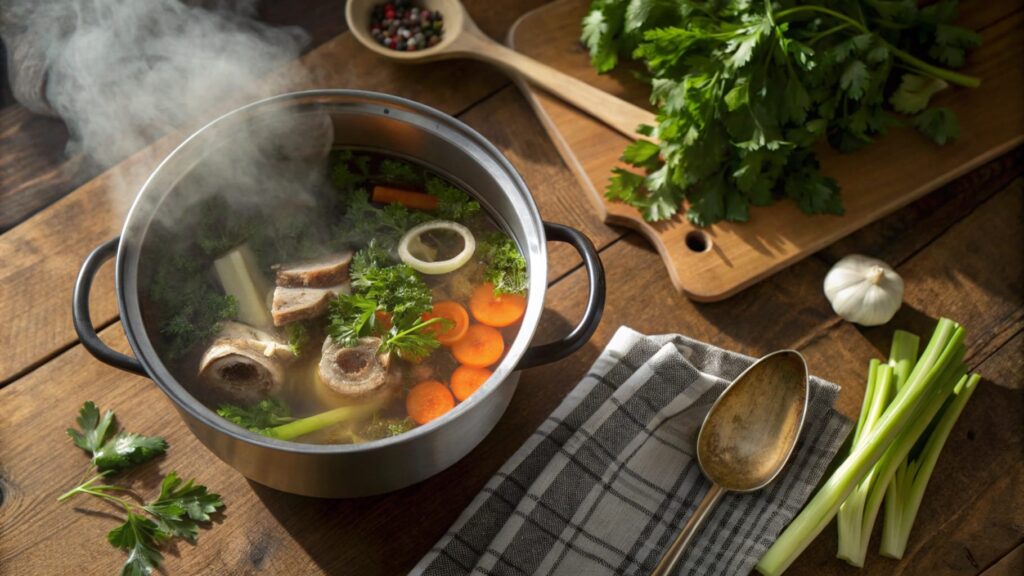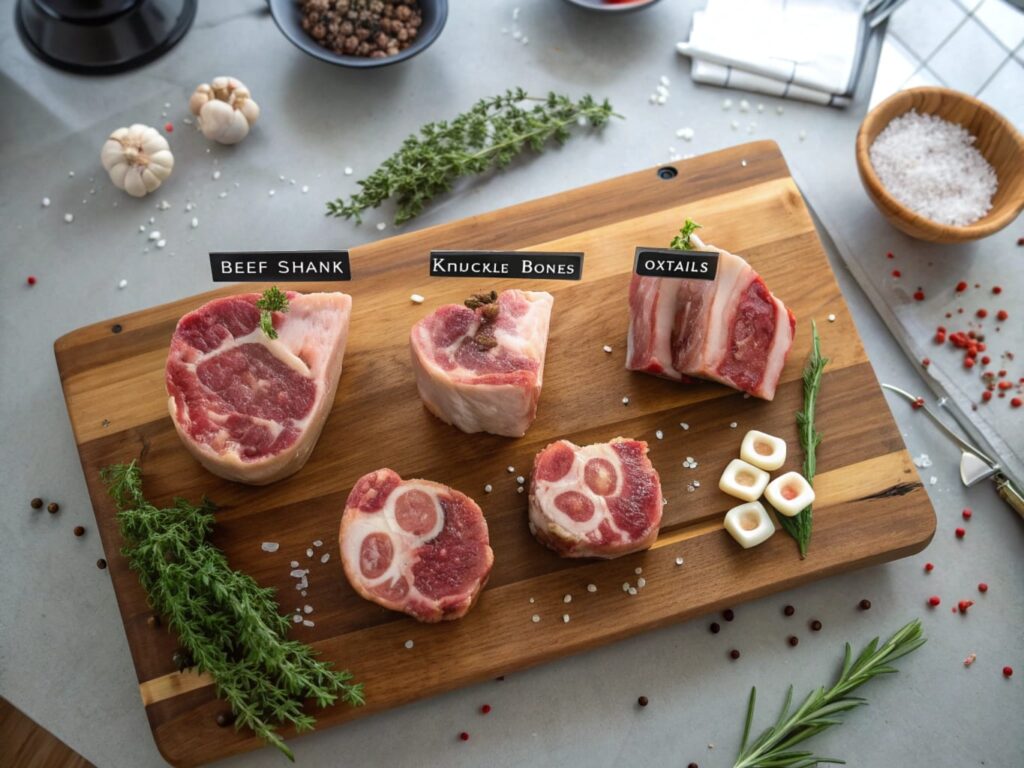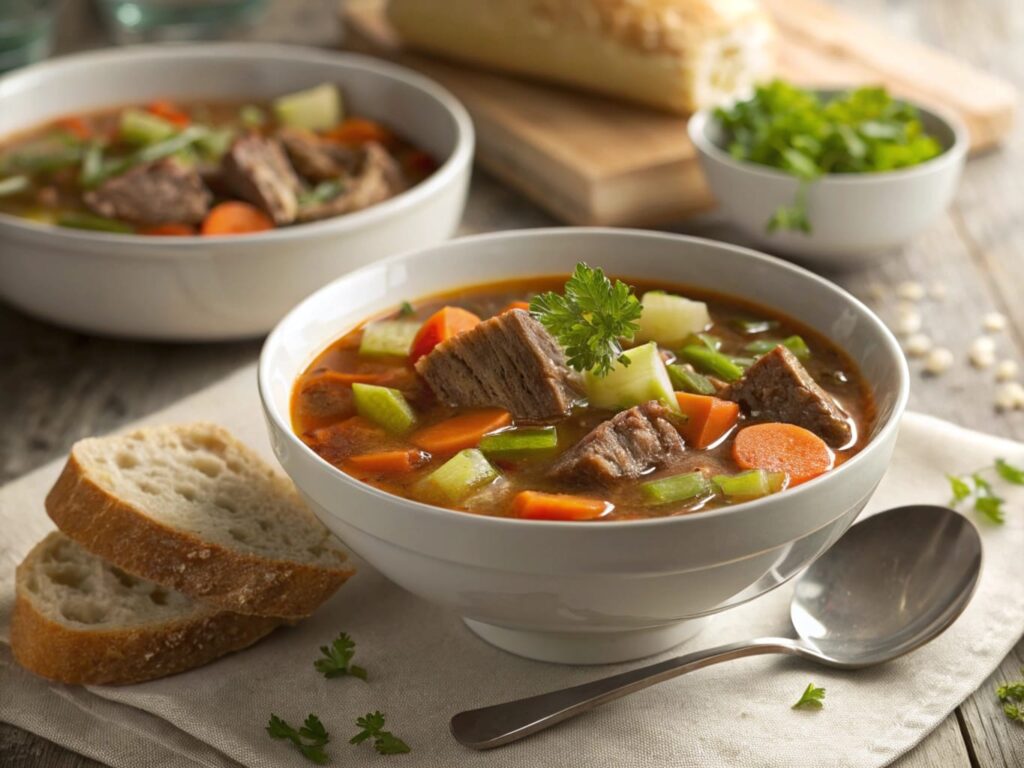Soup bones are a hidden treasure in the culinary world, offering both rich flavors and nutritional benefits. But have you ever wondered, “What cut of meat are soup bones?” These cuts, often overlooked, come from parts like beef shanks, knuckles, and oxtails. Known for their ability to create hearty broths and savory dishes, soup bones are a must-have ingredient for chefs and home cooks alike. In this guide, we’ll explore everything you need to know about these flavorful cuts—from their origins to their culinary and health benefits.

Introduction to Soup Bones
What Are Soup Bones?
Soup bones, also known as marrow bones or broth bones, are cuts of meat that contain a combination of bone, connective tissue, and sometimes a bit of meat. These bones are commonly sourced from beef, pork, or even chicken and are prized for their ability to infuse rich flavors into dishes.
The star of these bones is the bone marrow, which melts into the broth during cooking, imparting a velvety texture and a deeply satisfying umami taste. Typically, soup bones are used to create stocks and broths, forming the foundation of countless soups, sauces, and gravies.
Why Are They Important in Culinary Traditions?
For centuries, soup bones have been a cornerstone of cooking across cultures. From the nourishing bone broths of East Asia to hearty European stews, they represent both practicality and flavor. Beyond taste, they provide collagen, gelatin, and an array of minerals that contribute to both culinary richness and health benefits.
Whether you’re simmering a pot of beef stock or crafting a classic French consommé, soup bones add complexity to any recipe. Their significance transcends the kitchen, highlighting the value of utilizing every part of the animal in a sustainable, waste-reducing way.
Understanding the Cuts of Meat in Soup Bones

Common Cuts Used for Soup Bones
When it comes to answering the question, “What cut of meat are soup bones?”, it’s essential to know which parts of the animal are typically used. Soup bones often come from cuts that are rich in connective tissue and marrow, such as:
- Beef Shank: A popular choice for broths, beef shank includes both bone and tender meat, delivering bold flavors.
- Oxtail: This cut packs a punch with its gelatin-rich texture and deep, savory taste.
- Knuckle Bones: Known for their high collagen content, knuckle bones are ideal for creating silky broths.
- Neck Bones: These smaller bones add a delicate flavor and are perfect for slow-simmered soups.
Each cut contributes a unique taste and texture, making it easy to tailor your recipe to your preferences.
Nutritional Profile of Soup Bones
Soup bones aren’t just about taste; they’re a nutritional powerhouse. As they simmer, bones release collagen, gelatin, and minerals like calcium and magnesium, making them a healthy addition to any dish. These nutrients are particularly beneficial for joint health, skin elasticity, and gut health.
Flavor Profiles of Different Cuts
Different cuts of meat yield distinct flavors. For instance, oxtail creates a richer, fattier broth, while knuckle bones are prized for their clean, neutral taste. Pairing the right cut with your dish ensures a balanced and flavorful outcome.
Benefits of Using Soup Bones in Cooking
Health Benefits of Collagen and Gelatin
One of the standout advantages of using soup bones is their ability to release collagen and gelatin. These components not only thicken your broth but also promote skin health, strengthen nails, and support joint mobility. By asking, “What cut of meat are soup bones?”, you’re already prioritizing ingredients packed with nutritional value.
Minerals and Nutrients Released During Cooking
Slow cooking soup bones allows them to release a wealth of minerals, including calcium, phosphorus, and magnesium. These nutrients are essential for bone health, making soup bones a smart choice for anyone looking to boost their intake of natural vitamins.
Cultural and Historical Significance of Soup Bones
Soup bones have been used for centuries to stretch meals and reduce food waste. Cultures worldwide—whether it’s the hearty soups of Europe or the nutrient-rich bone broths of Asia—have relied on these cuts to add both sustenance and flavor.
By incorporating soup bones into your cooking, you’re not just making a meal; you’re continuing a tradition of resourceful and flavorful cuisine.
Recipes and Culinary Uses for Soup Bones

Traditional Broths and Stocks
Soup bones shine as the heart of traditional broths and stocks, delivering both flavor and nutrition. Whether you’re making a simple bone broth or a complex stock for ramen, soup bones are unmatched. The secret lies in their ability to release collagen and marrow, creating a rich, velvety base.
Try simmering beef shank or knuckle bones with onions, carrots, and celery for a classic stock that enhances soups, gravies, and risottos.
For more tips on making a perfect broth, check out Soup Bones Guide.
Popular Soup Recipes with Soup Bones
There’s no shortage of recipes that use soup bones. From hearty vegetable beef soup to traditional Vietnamese pho, these versatile cuts bring depth to every dish. A slow-cooked oxtail stew pairs perfectly with root vegetables, while marrow bones elevate creamy potato soups with their luxurious texture.
For additional recipe inspiration, read What Bones Are Best for Soup.
Innovative Dishes Beyond Soups
Soup bones are not limited to soups and broths—they can also be repurposed for innovative dishes. Roast beef marrow bones and spread the softened marrow over crusty bread for a decadent appetizer. Alternatively, use the shredded meat from simmered neck bones to create flavorful tacos or casseroles.
If you’re curious about additional ways to enjoy soup bones, visit What Is Considered a Soup Bone.
Tips for Selecting and Storing Soup Bones
How to Choose Quality Soup Bones
Selecting the best soup bones starts with knowing what to look for. High-quality bones should have visible marrow and some connective tissue for maximum flavor and nutrients. Cuts like beef knuckles, oxtail, and shanks are excellent choices. If possible, source bones from grass-fed animals, as they tend to offer more health benefits and a cleaner taste.
Best Practices for Storing Soup Bones
Proper storage is essential to keep your soup bones fresh and ready to use. Fresh bones should be refrigerated and used within 3-5 days. For longer storage, freeze them in airtight bags or vacuum-sealed containers for up to six months. Label your packages to avoid forgetting what’s inside.
Signs of Spoiled Soup Bones
It’s vital to recognize when soup bones are no longer safe to use. If they have a sour smell, a slimy texture, or discoloration, it’s time to discard them. Using fresh ingredients ensures both safety and superior flavor in your dishes.
For more delicious recipes featuring soup bones, check out our extensive guide at Are Soup Bones Good to Eat.
Part 6: FAQ: Common Questions About Soup Bones (200 Words)
What Is the Best Cut for Making Broth?
When it comes to creating a flavorful broth, the best cuts of meat for soup bones are those packed with collagen and marrow. Beef shanks, oxtails, and knuckle bones are top choices because they release gelatin as they cook, creating a velvety texture. If you’ve ever wondered, “What cut of meat are soup bones?”, these options are perfect for adding depth and body to your broth.
How Long Should You Cook Soup Bones?
Cooking soup bones takes time, but the payoff is worth it. For a rich broth, simmer your bones on low heat for 12-24 hours. Short on time? A pressure cooker can reduce the cooking time to just a few hours while still extracting the nutrients and flavor.
Can You Reuse Soup Bones?
Yes, you can reuse soup bones for multiple batches of broth, although each subsequent batch will be lighter in flavor. By adding fresh vegetables and seasonings, you can still create a delicious stock. Just remember to discard bones that have become brittle or lost their structure.
For more answers to soup-related questions, check out What Bones Are Best for Soup.
Beyond Broth: Sustainability and Ethical Considerations
Maximizing the Use of Every Part of the Animal
Using soup bones aligns with the sustainable practice of utilizing every part of the animal. Cuts like neck bones, knuckles, and marrow bones might otherwise go to waste, but in the kitchen, they transform into the foundation of nutritious meals. By asking “What cut of meat are soup bones?”, you’re participating in a movement that values resourcefulness and respect for food sources.
The Role of Soup Bones in Reducing Food Waste
Soup bones exemplify the idea of waste reduction. Not only do they extend the life of an animal product, but they also allow you to repurpose scraps into something extraordinary. Leftover meat from simmered bones can become fillings for tacos or additions to pasta, making the most out of every ingredient.
Choosing soup bones is a step toward eco-friendly cooking, proving that sustainability can be delicious. For even more ideas on minimizing food waste, visit Are Soup Bones Good to Eat.

